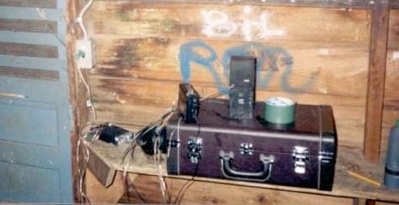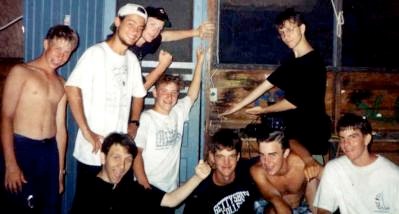Invention, Creations, and Innovations
by Nick Berg


If you have or know of another Berg creation, please let us know at Stories@nickberg.org.
Door Alarm

My first memorable experience with Berg (as told by Luke Lorenz) was the unforgettable improvised alarm system devised with a piece of scrap aluminum foil and a jury-rigged walkman to protect our cabin from undesirables at band camp. We were the only cabin with a prank deterrent system! (it even worked the one-and-only time an instructor walked in) If you opened the door you heard this.

No girls were gonna sneak into our cabin! Perhaps it worked too well…
-Luke Lorenz ,Boalsburg, PA
Thanks Brian Hamrick for the photos!
Nick is in the center, kneeling with the white shirt
Invert Alert
The invert alert was a neat little device that Nick created for his grandma to wear around her neck. It used a motion sensing and position sensing switch together to sense a "fall" which would involve acceleration and quick arrest combined with a position change. This then broadcasted a signal to make the home's doorbell sound -- the door bell was positioned next to where his grandfather sat, thereby alerting him to the fall, or that someone was standing at the door constantly pressing the doorbell.
-Thomas Clardy
There were other versions of Invert Alert. Nick had one that scrambled all transmission signals in a localized area. So if the TV got fuzzy, or the radio, or portable phone - you better check on Grandma!
Berg did demonstrate his device during a stage production at Henderson High School. The sound techs used walkie talkies to communicate to the stage manager. Imagine the confusion when every headpiece is filled with static! Quickly he gave a humorously repentant look and turned off his device.
Random Number Generator
Berg made a duck taped box with circuits and red l.e.d.s (little lights) that came up with random combinations whenever you pressed the two extended wires to your skin. The lights were aligned and the way they lit up indicated a number; it was based on the binary counting system. For those unfamiliar with 'binary’ here is a quick and easy example:
We are used to counting eight, nine, ten. Well, ten is really one (in the tens place) and zero (in the ones place). To make this understandable, in computer speak, nine is really 09 or even ...000009. add one and you get 10 or 0000010.
Well In binary you can only get to 1 in any 'place'. If you add one, the one moves over to the left. like so:
000 + one = 001
001 + one = 010
010 + one = 011
uh oh, now what? well, if you add another one, you have to carry the one left over (just like in the normal base ten system we are used to using) so you get 011 + one = 100
So, if the lights combination was
001 the number was one.
If 010 the number converted to two.
if 011 the number was three and 100 was four and so on.
Funny that if you use this system with your fingers you can count to 31 and if you use two hands you can count to 1023!
Don't try this at home kids, you might go crazy!
The Truth Detector
A later model of the Random Number Generator was the Truth Detector. The device used resistance in the skin (when you touched two wires) to (obviously!) came up with different light combinations based on how "truthful" one was! Did it really work? Well, before I answer that, let me get my Truth Detector....
It was simply soldered transistors and logic gates with an l.e.d. display. The name for the device was whimsical. We guessed that a higher number meant more truth and a lower number meant less truth, but really the truth detector was designed as a toy, to stir creativity, and spark an interest in electronics. Berg taught circuit building (among other things) at Summer Science classes in the West Chester Area School District under the direction of Mr. Jim Wakefield. Nick built and gave me a similar device for my birthday. At the time I could not read binary and now I can. Most of Berg's inventions had a didactic quality while stirring the imagination. Some were so complex that we could hardly understand the theory he was trying to convey, much less the engineering of the device. - And some never worked when you wanted them to... like the huge “Pyramids of Power” speakers that Berg brought in for a dance at the high-school. Needless to say, there was more laughing than dancing as we could not hear the music.
Luke Lorenz
Conway's Game of Life implementation
----- Original Message -----
From: "Joe Blechman"
Hi Luke,
I just know a little about his project making Conway's game of life. He
made the whole thing out of L.E.D.'s. I understand the theories behind it, but as for nick's electrical wiring, I only have a vague memory...
here's an article on the theory behind it...
and an implementation...
http://www.bitstorm.org/gameoflife/
Date: Mon, 7 Jun 2004 17:26:58 -0400
From: Jut
Here's what I understand about Nick's implementation of
Conway's Game of Life:
Nick made many modular 'cells'.. Each cell was a circuit of transistors and a LED constructed using Nick's patented cardboard/duct tape circuit boards.
The LED indicated live/dead... He made a few different versions of these cells over time. The status of the LED was controlled by a simple logic circuit that made a 'decision' based on the alive/dead status of the cells in its immediate vicinity (4 cells on each side).
He would hook-up the cells in an array... and by poking a wire into a junction in each of the cells he could make it alive or dead... Once he set it up he turned on a clock circuit which would make the whole thing iterate through its life-span. The clock circuit could be adjusted so you could watch the life-cycle slowly or quickly.
There's a ton of little freeware programs and student projects that you can download to see how it works... it's pretty fun to play with and is a common programming assignment in basic computer science courses.
What was cool is that Nick did it purely with transistors. The meant he had to construct logic gates 'from scratch' using several transistors for each gate. Each cell probably used 10 or so gates... which meant that each cell involved maybe 20 or 30 transistors. Which involves a lot of soldering, planning, and repetition.
jut
Bovl Blocks
Nick's tower design is incredible. They are pored-form concrete blocks. The blocks assemble to form a tower. They are "internally guyed" -making it a "three wire, internally guyed concrete block tower". Running through the center of each of the outside blocks (not the center key blocks) is a narrow PVC pipe that the guy wire runs through. This guy is then attached to a steel frame sitting on the ground and tensioned down (with a wrench). Nick first demonstrated this tower design to the world at a conference where I met up with him in Hershey, PA on October 30ith, 2003. We were there together and I (feebly) helped him in whatever way I could to assemble the tower. The conference was the 19th annual meeting of the Pennsylvania Association of Broadcasters. (PAB)
-Thomas Clardy
Thanks Thomas Clardy for the image.
Man is more than fire tamed...
Hosted by: Professional Web Concepts, Inc.
stories@nickberg.org
All content and submissions copyright nickberg.org 2004
